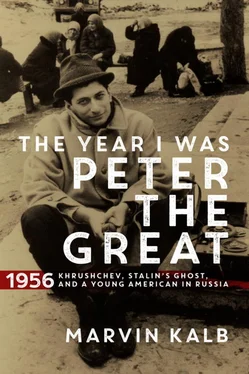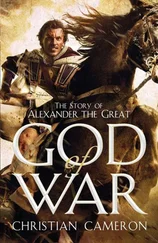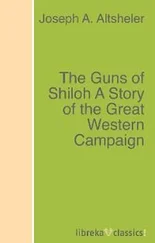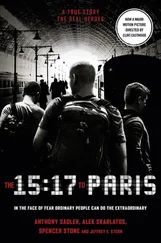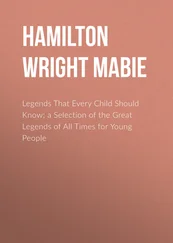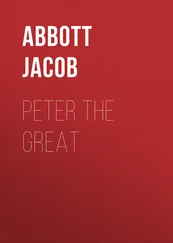On February 19, an unusually bright Sunday, I joined a small group of diplomats and journalists for a forty-five-minute ride to the official American rest house, or dacha, in the Moscow suburbs. “Once you leave the immediate heart of the city, you enter Russia,” I wrote in my diary. “For the heart of Moscow, big and blaring, is not Russia. Russia, it seems, is the small wooden cottages, or huts, which sit at different points of a wide expanse of white, snow-covered plains.”
The Soviet Union was a superpower with thousands of nuclear weapons, but it was also a third world country. Hard to imagine, but true. Away from the glitz of the capital and a few of the other large cities, such as Leningrad and Odessa, Russians continued to live in Slavic squalor. Small towns in 1956 resembled small towns a hundred or so years before.
On April 2, I took a train on a 100-mile journey northeast of Moscow to a troika of towns that centuries earlier symbolized czarist power: Vladimir, Suzdal, and Bogolyubovo.
The town of Vladimir dates back to the early twelfth century, when it became the unofficial capital of Russia. A kremlin, or fortress, was built on a summit overlooking the town. From there, the Russians fought the invading Mongols in 1238. Now this kremlin served as headquarters for the local branch of the Ministry of State Security (MGB). The doors were shut—no one allowed in, a guard informed us. Not discouraged, we walked quickly to the astonishingly beautiful Dmitriyevsky Sobor, translated roughly as “monastery,” built in 1194, where we marveled at the old frescoes painted by Andrei Rublev, one of Russia’s greatest painters. Vladimir, though endowed with an impressive history, looked tired.
Then, instead of eating lunch in Vladimir, we rented a car and drove twenty-five miles to Bogolyubovo, once a center of religious learning, now a tiny, unwashed town known for the small, white square church with the single cupola sitting on a lonely hilltop in the near distance. Regarded justifiably as an architectural masterpiece, this magnificent church, now empty, called Pokrov Na Nerli, looks down on miles of snowy countryside, a reminder for me of the historian Sir Bernard Pares’s observation that in Russia sky and earth seemed to meet and become one, giving rise to a mystical belief in many Russians that somehow they were closer to God than other people.
The following day we drove to Suzdal, thirty-five miles northeast of Vladimir. It had a courageous past, battling the Mongols, but its present-day life seemed sad and dull. Once it was home to thirty-six churches; now not one functioned as a church. It had three monasteries; now one served as an electric power station, another as a training center for KGB troops, and the third we were not allowed to see.
“Why?” I asked the guard.
“There is nothing inside,” he replied.
“Well then,” I said, “can we see the nothing inside.” The guard did not appreciate my humor. He walked away in a huff.
Yet, as I noted on the train ride back to Moscow, our farewell from Suzdal was memorable. A small group of people gathered around our car, waiting for us. They wanted to talk. More than anything, they wanted to stress that they did not want war.
“The American people are a good people,” one of them said. “We Russians are a good people.” Nodding for emphasis, he added, “You don’t want to fight. We don’t want to fight. That’s good.”
One young man pleaded for greater understanding and proposed increasing exchanges between the two countries. I asked no one in particular what people thought about Stalin’s now-discredited “personality cult.” “Better late than never,” someone said.
I continued on this theme, “Where were your current leaders when Stalin did all these terrible things?”
An uncomfortable silence descended on our conversation, broken only when a young man spoke of his faith in God. “I know that God will help us all,” he said loudly, “all of us, no matter. He will wish us well. God can do such things, you know.”
Throughout this friendly exchange, an old man held my hand. He did not let go. He kept repeating in a low mumble, “Please tell the American people we love them very much and do not want war.” He started to cry, still refusing to let go of my hand. Like so many Russians, he feared war. He wanted us to appreciate the depth of Russian suffering during World War II. It was for me a very moving experience.
The train stopped once on its way back to Moscow. I took advantage of the stop to breathe fresh air. I had not been feeling well since lunchtime. On the platform I asked a peasant woman running an improvised snack bar for a glass of tea. She did not have tea but she did have vodka. “No,” I said, waving her off, “no vodka.” She looked at me with sudden sympathy.
“Your stomach?” she asked.
I nodded.
“Where are you from?” she wanted to know.
“America,” I replied, puzzled. What did my nationality have to do with my stomach problem?
The woman, reading my mind, explained. “I have met other Americans with stomach trouble. Always the same reason—Russian food is too greasy. Trust me,” she said, “one hundred grams of vodka with each meal, and you won’t have problems anymore.” She was right, although sometimes I needed 200 grams.
On April 22 a few reporters and I drove to Zagorsk to see the famous Troitsky Monastery, a wondrous sight of high walls, priests in training, and parishioners in prayer, with church bells breaking into the musical liturgy every fifteen minutes. Zagorsk played a key role in the sixteen-month defense of Moscow against the attacking Poles during the Time of Troubles, a brief but intense period of political upheaval in the early years of the seventeenth century.
As I prepared to leave a young Russian approached me. “Are you an American?” he asked softly. No sooner had I replied, “Yes,” than he urged me to follow him into the museum’s men’s room. I did so, reluctantly. There, from under his coat, he removed two files. “These are my father’s. They will show you, prove to you, point by point, how awful things are in this country.” I told him I could not take his father’s papers. I was concerned that he might be KGB, setting me up for a classic sting. He appealed to me again and again, describing himself as an expert mechanic who had been out of work for three months.
“Take me with you,” he pleaded.
I shook my head. “No, that is not possible.” As I headed toward the door, I asked, “Aren’t you afraid that people will see you with a foreigner?”
He laughed. “If they threw me into prison, what difference would it really make?”
I wondered on the drive back to Moscow how many young people were desperate enough to ask a foreigner for help.
On June 17 I drove three and a half hours to Yasnaya Polyana, the birthplace and home of Leo Tolstoy, Russia’s greatest novelist. Millions have read his books War and Peace and Anna Karenina , and his life story has been studied for an understanding of his doctrine of nonresistance, which profoundly influenced Mahatma Gandhi and the Reverend Martin Luther King Jr. Tolstoy had served in the Russian army during the Crimean War and then in smaller wars against Muslim tribesmen in the northern Caucasus. Toward the end of his life he was regarded as a saint, and many Russians brought their children to Yasnaya Polyana, hoping they would be impressed and influenced by the wisdom and wonder of Tolstoy.
I overheard one docent telling her group that Tolstoy especially admired Russian writers. She raved about his love of Maxim Gorky. He considered Gorky a “great artist.” Puzzled, I asked my guide whether that was true. He waited until we had left the main building before answering. “When peasants come to Yasnaya Polyana, that’s the sort of thing we tell them. But that’s propaganda,” he said with no shame. “That’s not for you or me.”
Читать дальше
